this paper describes performance evaluation of VoIP over IP/MPLS networks using OPNET tool. The simulation study is completed by running VoIP application in different network scenarioswith different interior routing protocols; namely: RIP, OSPF and EIGRP and with different queuing techniques to measure quality of service. However, the main network model is built of TCP/IP routers with MPLS routers in the core of the network case study (middle). This model enables different TCP/IP networks communicating to each other through the MPLS core routers. The following performance parameters: the delay (jitter) (sec), packet delay variation, packet end-to-end delay (sec), and number of packets sent/received are used to compare the efficiency of different networks.
Keywords |
| multimedia; VoIP; routing and QoS; queuing and QoS; IP networks; MPLS networks |
INTRODUCTION |
| Multimedia streams require higher bandwidth than any other data types over the Internet. Besides that, the number of
the Internet users are growing very vastly and their usage of the multimedia applications are increasing very rapidly
too. In addition, users are asking more and more for advanced features of the multimedia applications. In turn, this is
guided by mobile devices growth from the industry side; as well as by the rich features that are available on the social
networks web sites [1]. Thestreaming of multimedia over the Internet requires special treatment in order to be
completely delivered and played back in correct order and in continuous time with suitable degree of quality of service
(QoS). However, such requirements can be listed as follows. First; packet sequencing, this is needed to report packet
loss, make packet reordering, perform out-of-order decoding. Second; time-stamping and buffering, in order to provide
continuous play out of the streams and to reduce delay jitter. Third, payload type identification and classification; this is
to facilitate media interpretation and to do suitable conversions easily when needed. Fourth, error concealment; this is
necessary to detect and repair errors by using redundancy or any other technique. Fifth; QoS; it is an essential
requirement to keep multimedia streaming flow to the appropriate service level and to enhance QoS between senders
and receivers. Last; rate control rule; this means making suitable adjustments during the stream flow to tolerate network
congestion.Nowadays, multimillions of multimedia streams need to be transferred between different corners of the
world’s continents through social networks and multimedia web sites with minimal delay overhead, with efficient
routes, using appropriate level of adequate QoS. Hence, multicast routing has become the most crucial issue in
international networking world’s infrastructure [2]. |
| This paper presents a comparative study of the performance of routing algorithms on the main QoS parameters of VOIP
traffic. The paper is organized as follows: Section 2 provides the literature review. Section 3 gives a brief insight about
routing. Section 4 describes the main features of MPLS technology. Section 5describesa brief discussionof multimedia
focusing primarily on the key QoS parameters of VoIP. Section 6 presents an analysis of the simulation results; and
finally Section7 outlines the conclusion of this research. |
RELATED WORK |
| There are several works have been carried out by other researchers in this field. However, this section gives an
overview of some important research papers. In [12] authors demonstrated that OPNET can be used by network designers to select the appropriate routing protocol for different networks and to design a suitable routing topology for
a given case study [12]. They showed video conferencing packet end-to-end delay and voice packet delay variation for
certain design example. But, they have not showed any VoIP or video conferencing detailed parameters and have not
involved any further performance of QoS measures such as queueing. |
| In [13] authors presented an analysis study of the queuing algorithms and the encoder selection on the QoS of VoIP
streams. They have not considered the effect of routing algorithms on the produced results. In addition, the paper
studied the effect of two encoders only; G.711 and G.729. Hence, the paper made evidence that the performance of the
queuing method is not affected by the used encoder for VoIP traffic flow [13]. This work also lacked on details about
the configuration parameters of the employed VoIP traffic in the experiment. |
| In [13] authors presented an analysis study of the queuing algorithms and the encoder selection on the QoS of VoIP
streams. They have not considered the effect of routing algorithms on the produced results. In addition, the paper
studied the effect of two encoders only; G.711 and G.729. Hence, the paper made evidence that the performance of the
queuing method is not affected by the used encoder for VoIP traffic flow [13]. This work also lacked on details about
the configuration parameters of the employed VoIP traffic in the experiment. |
| In [16] the authors have made a comparison between interior gateway protocols (IGP) such as routing information
protocol (RIP), open shortest path first (OSPF), interior gateway routing protocol (IGRP) and enhanced interior
gateway routing protocol (EIGRP) with only a weighted-fair queuing (WFQ) technique on different scenarios.
However, this work limited with only WFQ queuing with VoIP and video conferencing. |
| In [17] the authors presented an analysis of the effect of different queuing techniques on the performance of VoIP using
multipath dynamic routing. However, the paper showed more configuration information about the case study, but it
hasn’t included other routing algorithms on the evaluation process. |
| In [18] the authors studied the performance evaluation of VoIP with respect to selected QoS parameters, the network
environment, and the virtual private network (VPN) protocols. They showed more detailed results about some
multimedia protocols such as RTP, SIP and H.323; but they have not included routing in their analysis [18]. |
| However, all of the research papers mentioned above have not included multiprotocol label switching (MPLS) into
their analysis studies. In addition, none of them made a complete set of analysis with different routing protocols with
different queuing mechanisms in clear parameter configuration values. However, our work includes a thorough analysis
study of the role of routing algorithms in QoS with and without MPLS technology, using three different queuing
techniques for VoIP application. The experimental study casesinvolved are as follows:- |
| - three different IGP routing algorithms (RIP, OSPF, EIGRP); |
| - each with three different queuing scheduling techniques; |
| - each with/without MPLS. |
| - each with VoIP application; |
| In another words, a 3D exploration vision with 3 axes (routing, queuing, MPLS) allowed us to create many detailed
scenarios to compare the effect of each queuingmethod with the three different routing protocolsand each routing
protocol with three distinct queuing all with/without MPLS, and all for VOIP streaming. |
ROUTING |
| Routing involves selecting a path from a source node to a destination node in a particular topology, whereas a topology
determines the ideal performance of a network. Routing process occurs at layer 3 (the network layer) of the OSI model.
Routers usually make the packet forwarding on the basis of routing table that is stored in router’s memory. The routing
table maintains a record of the routes to various network destinations based on network topology [2] [3] [4]. Routing
can be classified as static and dynamic routing. Static routing means configuring the routing tables in the routers within a network prior to operation. It is mainly used in small networks, with two or three routers and a few IP subnets. Static
routing is simple, it has lower overheads so it does not consume network’s bandwidth, secure and it is easy to revise
quickly. However, static routing is not scalable as the network’s size grows and static routing unable to adapt to any
changes in the network structure such as link failure or adding new routes.In dynamic routing the routers build their
own routing tables through information exchanged with each other during run time. No static configuration is required.
However, the time taken by the routers to quickly update their routing tables to reflect the changes may occur to the
network connectivity is called convergence. Different dynamic routing algorithms employ different procedures to
reduce convergence time. Dynamic routing is used in medium to large networks and scale well to large networks.
Moreover, it has the ability to do rerouting in case of network topology’s changes, network congestion or link failures.
Dynamic routing can be categorized into link-state routing protocols and distance-vector routing protocols. Link-state
routing protocols need the entire routers of the network to know almost all the paths that are accessible by all other
routers in the network. Distance-vector routing protocols comprises two factors: the distance, or metric, of the
receiver’s endpoint, and the vector, or direction need to be taken to reach that endpoint. Routing information is only
exchanged between straight linked routers; however, a router can't see outside its own neighbors. Disadvantages of the
distance-vector protocols are: slow convergence, counting to infinity problem, lack of range of metrics, no opportunity
of hierarchical routing and inefficient performance in great networks. Link state features: information about adjacencies
sent to all routers only when there is a change; each router retains a similar database; a “shortest path” algorithm is
involved to determine the finest route and converge quickly as possible as databases can be reorganized. Link-state is
better because: fast loopless convergence, support of precise metrics and, can employ multiple metrics when needed,
maintain multiple paths to a destination and splitting very large networks in areas. On the contrary, link-state routing
class has the following disadvantages: additional memory is needed because the link-state database is required with the
routing tables and it is need considerably complex procedure to learn more routes [1] [2] [3]. |
| A. RIP protocol: |
| RIP is a dynamic routing of kind distance-vector routing protocol and it is based on the Bellman-Ford algorithm. RIP
protocol is the first routing protocol used in the TCP/IP-based networks. RIP sends information through the network
using UDP protocol. RIP protocol is employed to exchange routing information within an autonomous system (AS).
RIP protocol is easy configurable and simple protocol that uses a hop count mechanism to find an optimal routing path;
where a maximum number of 16 hops are retained to avoid routing loops. However, this parameter limits the size of the
networks that are supported by this protocol. In contrast with OSPF; RIP provides only a simple form of authentication,
it has slow convergence times, and its network size scalability [1] [2] [3]. |
| B. OSPF protocol: |
| OSPF is a dynamic routing protocol of type link-state routing protocol. OSPF is designed specifically to work on
TCP/IP networks. Moreover, OSPF utilizes Dijkstra’s shortest path first algorithm to determine the shortest path.
Being an IGP protocol OSPF distributes routing information between routers conforming to a single AS. However,
OSPF designed to run internal to a single AS; where, each OSPF router retains an identical database representing the
AS’s topology. Using this database, a routing table is calculated by building a shortest path tree. The tree gives the
entire path to any destination network or host. However, OSPF responds quickly to any topological changes; hence,
OSPF recalculates new routes using a minimum traffic of the routing protocol. OSPF was developed to overcome the
incapability of the RIP protocol of serving large, heterogeneous networks. OSPF runs directly over IP and provides
load balancing by spreading traffic across various routes to a specific destination. OSPF supports authentication to the
routing process and enables exchanging of routing information from/to external sites. Moreover, OSPF allows great
flexibility and delivers transfer and tagging of external routes inserted into AS [1] [2] [3]. |
| C. EIGRP protocol: |
| EIGRP is a Cisco-proprietary hybrid routing protocol with integrating characteristics of both distance-vector and linkstate
routing protocols. EIGRP uses diffusing update algorithm (DUAL) to find the best path from all possible paths.
DUAL also assists avoiding loops that may take place in routing. EIGRP protocol’s updates are sent when a change
occurs between neighbor routers in the same AS, and it contains only the changes occurred in the network state. This
feature minimizes the bandwidth required for EIGRP packets. Moreover, EIGRP protocol scales well to large networks,
preserves back up path to reach the destination and supports routing update authentication [1] [2] [3]. |
MPLS |
| MPLS is an improved method for routing packets through a network using information contained in labels attached to
IP packets. The labels are inserted between the Layer 3 header and the Layer 2 header. The primary objective of MPLS
is to create a flexible networking framework that delivers boosted performance and stability. This take account of
traffic engineering (TE) and virtual private Network (VPN) competencies that is present QoS with several classes of
service (CoS). Traditional IP packet forwarding uses the IP destination address in the packet’s header to decide the next
forwarding hop at each router independently without considering any other routing factors in the way toward the
destination end. These hop-by-hop decisions are based on network layer routing protocols, such as OPSF or border
gateway protocol (BGP). These routing protocols are designed to find the shortest path through the network, and they
do not consider other factors, such as latency or traffic congestion. However, MPLS constructs a connection-based
model over the ordinary IP connectionless networks. This connection-oriented architecture releases the access to rich
new features and possibilities for managing data streams in an IP networks using new MPLS technology which
combines the intelligence of routing with the high performance of switching [5] [6].The essential idea behind the
MPLS technique is the router’s structure. In the MPLS’s router there is a separation of the standard IP router’s
functions into two parts: forwarding (data) plane and controlplane. The control plane is responsible for keeping the
routing data and other control information, such as label bindings, which are exchanged between label switch routers
(LSRs). However, MPLS is a control plane guided protocol. Thus, the control information needed for exchange must
be ready before forwarding the first data packet. MPLS uses Label Distribution Protocol (LDP) to establish label
mappings in MPLS network domain to facilitate much control over the packet’s path by referencing the incoming
labels to the label information base (LIB). In the MPLS framework LSR must come to an agreement on the meaning of
the labels used to forward traffic between and through them. LDP is a protocol that describes a set of procedures and
messages that are used by any LSR router to inform another LSR router about the label bindings it has generated. The
LSR employs LDP protocol to create label switch path (LSP) over the network by mapping network layer routing
information directly to data link layer switched paths. These LSPs may have an endpoint at a directly attached neighbor
(like IP hop-by-hop forwarding), or may have an endpoint at a network egress node, facilitating switching through all
intermediate network nodes. However, forwarding equivalent class (FEC) is associated with each LSP created. This
FEC specifies which packets are mapped to that LSP. Moreover, any two LSRs that are using LDP to exchange label
mapping information are known as LDP peers and they have an LDP session between them [5]. The MPLS forwarding
plane is in charge of forwarding packets based on values enclosed in appended labels. The forwarding plane uses LIB
retained by the MPLS nodes to forward packets [5] [6]. |
MULTIMEDIA |
| Over the past years, the Internet has been full-grown and scaled internationally and the Internet became a corner stone
in multimedia communicationseverywhere in people’s daily life (e.g. VoIP, video on demand and video conferencing,
and e-commerce). However, every multimedia session described as follows [2] [7][8] [9]: |
| - Location: it’s usually the IP address of the sender and receiver; |
| - Status: availability of the user (online/offline); |
| - Capacity: issues like bandwidth, buffering, reservations if any; |
| - Settingup: steps taken by the protocols to start up the session’s initiation (control signals); |
| - Progressing: start the transfer and continuation of voice/video/data packets flows; between senders and |
| receivers; |
| Termination: proper closing of the session between participants (disconnecting the communication).
Multimedia applications can be classified into (i) streaming stored audio/video; (ii) conversational voice/video-over-IP;
and (iii) streaming live audio/video. In the following section a brief description about VoIP, video conferencing and
their QoS requirements are presented. |
| A. VOIP: |
| VoIP technology operates by converting voice data into a digital format that can be delivered through IP networks as a
series of packets. These digital voice packets then carried by communication networks, using either a carrier network or
the Internet. However, the cost is the essential key motivating the deploying of VoIP networks. Hence, telecom
companies setup new infrastructures, added better-quality to multimedia and invested in large-scale data networks. |
| Moreover, there are great demands for multimedia communications guided by user’s requirements and big pressure
guided by industry side for integration of voice and data networks in one single cost-efficient infrastructure network. In
traditional public switched telephone network (PSTN), switching is used to connect two separate phone circuits into
one single line to make the phone conversation between the calling parties. Whereas, in VoIP case software switching
can be used to signal, control and makeup the connections over IP networks to complete the phone calls. Moreover,
there are some significant issues have been influenced on the reusing of the traditional IP networks as a VoIP running
vehicle. These issues include: QoS, using standards by vendors to keep interoperability, security, integration with
PSTN and scalability [1] [2] [8]. |
| B. QoS requirements for VoIP |
| The network that delivers QoS is a network that keeps certain level of delivery of number of packets. Ensuring high
quality for a voice call over the “best effort” IP network is the crucial task in transporting VoIP traffic. However, QoS
demonstrates a systematized collection of approaches that are used to control network bandwidth, end-to-end delay,
jitter, and packet loss to achieve an appropriate throughput to the network to fulfil real-time multimedia streaming
requirements. QoS for VoIP is defined using different parameters; the common factors are end-to-end delay, delay
variation (jitter) and packet loss ratio. Hence, the main goal of QoS is to control the delay jitter, one way end-to-end
delay and to provide a sufficient bandwidth to deliver the real-time multimedia traffic (e.g. VoIP) effectively within the
delay times acceptable limits.The delay Jitter is defined as the variability of consecutive packets delays within the same
packet stream at arrival to the receiving end; i.e. the inter arrival times between successive packets at the receiver
cannot be greater than a definite value as this will cause the interruption of the continuity of the play-out process due to
missing of data at correct play-time because of the variability of transmission delay.A packet loss is defined as the
number of packets that are lost during transmission process inside the network within a defined time period. However,
packet loss may occur due to: network congestion, lower layers errors, network element failures or due to the end
application errors.End-to-end delay is defined as the time it taken to deliver a packet from the sender to the receiver.
For real-time voice conversation (VoIP), the end-to-end delays between 150 and 400 msecs is acceptable but are not
perfect. Typically, the receiver of a VoIP call will define certain threshold (e.g. 400 msecs); any packets that are
delayed more than that threshold will be discarded [8] [9] [10]. |
| C. VOIP session: |
| Figure (1) shows the sequence of VoIP session establishment. The starting point is the caller requests (invite) the called
party by issuing SIP URL (i.e. aziz@xyz.com to ahmd@comp.com). If the caller knows the called’s location it can
send the request directly to the called’s IP address; otherwise it passes the request to local SIP network server (trying).
Then, the server will try to find the called’s location and forward the request using the registrar database or pass it to
known redirect server via a proxy. Once the called party is found the request sent to the user; hence user can accept or
decline the session setup. In case the user accepts the call the connection is setup and the user’s IP phone will start
(ringing), and the session starts negotiating the session requirements and capabilities to keep the session alive with
certain level of QoS till the conversation dialogue ends. Finally, after the both sides finish the VoIP call the session is
terminated [2] [8]. |
RESULTS |
| Figure (2) shows the IP/MPLS network case study illustrating node icons in OPNET which consists of the following
network elements: |
| - Six conventional IP routers (the outer ones): (R1, R2, R3, R4, R5 and R6); |
| - Four MPLS routers (the four insider): (MPLS_R1, MPLS_R3, MPLS_R3 and MPLS_R4) |
| - Two LANs each with 10VoIP stations |
| - Two VoIP stations: VOIP_Westand VOIP_East |
| - Two video conferencing stations |
| - Simulation parameters:call volume was defined for the simulation as 500 call with average call duration of
300ms/call using G.711encoding scheme with voice flow duration as 36000 seconds (1 hour) and the analysis includes
delays overhead bytes of TCP/UDP/IP/RTP and creation of full mesh between all the topology nodes; hence, the
OPNET created 240 voice traffic using traffic center to start the simulation. However, this technical configuration
indicates that a huge data is used for the simulation run in the case study to investigate the network topology running
the VoIP application comprehensively. |
| To evaluate the IP/MPLS networks performance with three different routing protocols with VoIP with three distinct
QoS queuing techniques different scenario have been built to measure and compare different combinations of routing
(EGIRP, OSPF, RIP), queuing (FIFO, PQ, and WPQ [7]), and MPLS. The following performance parameters are used
to perform the evaluation process: (the delay Jitter (sec), traffic sent/received (packet/sec), traffic dropped (packet/sec),
packet delay variation, and packet end-to-end delay (sec)). |
| - Results of comparing VoIP (packet delay variation) for the three routing protocols (EIGRP, OSPF, RIP) with
FIFO, PQ, WFQ queuing for IP network(without MPLS)are illustrated in figure (3). In addition, figure (4) shows the
same comparison but for the MPLS network. From figure (3), which describes IP network (no MPLS) it is clear that
EIGRP routing protocol is doing better in terms of voice packet delay variation; while RIP protocol is the worst in case
of FIFO queuing and doing better in both PQ and WFQ queuing. However, OSPF has nearly constant delay in the case
of PQ and WFQ queuing around 0.000012 value. In another hand; figure (4); which describes results of MPLS
network, clearly demonstrates that OSPF with MPLS doing much better that EIGRP and RIP protocols with FIFO, PQ
and WFQ queuing. Furthermore,OSPF with MPLS has almost a constant value near 0.00006 for PQ and WFQ queuing;
which is better thanboth EIGRP and RIP routing protocols. |
| - Results of comparing VoIP (packet end-to-end delay) for the three routing protocols (EIGRP, OSPF, RIP)
with FIFO, PQ, WFQ queuing for IP network (without MPLS) are demonstrated in figure (5); while figure (6) shows
the same comparison for the MPLS network. From figure (5) it is seen that OSPF produced the highest packet end-to end delay for all used queuing techniques and EIGRP protocol shaped the lowest value in IP network. But, for MPLS
network as seen in figure (6); OSPF protocol produced the lowest voice packet-end-to-end delay (nearly constant
value). |
| Results of comparing VoIP (voice jitter) for the three routing protocols (EIGRP, OSPF, RIP) with FIFO, PQ,
WFQ queuing for IP network (without MPLS) are presented in figure (7); while figure (8) illustrated the same
comparison for the MPLS network. However, for IP network; all the three routing protocols have nearly same values;
as seen in figure (7). But for MPLS network; the OSPF has the lowest value with the EIGRP protocol has the worst
values. |
| Results of further analyzing of PQ queuing for the path from node0-to-node8. This type of result to show that
the OPNET simulation tool can provide network designersmany other figures to further analysis the network topology
under design: in this casethe path node0-to-node8 point-to-point delay and the path node0-to-node8 throughput is
illustrated in figure (9) parts (a) and (b) respectively. However, figure (9) part (a) showed that OSPF has the lowest
queuing delay, while; part (b) depicted that OSPF has the highest throughput for the given path.In addition; figure (9)
parts (c, d) illustrated IP traffic dropped and voice traffic received for the case of IP network with PQ queuing; here;
EIGRP has the lowest drop value than that of OSPF and RIP protocols. |
CONCLUSION AND FUTURE WORK |
| In this experimental study that is carried out in this paper we have used OPNET simulation platform as a tool to make
the performance analysis. The VoIP has been selected as a candidate application because it is the most commonly used
application by millions of people over the Internet. The simulation results showed that the introduction of MPLS into
IP networks improved the multimedia streaming by reducing packet delay variation and end-to-end delay due to the
enhanced capabilities of MPLS. It is seen also that OSPF is performing better with MPLS than the EIGRP and RIP
protocols in terms of delay (jitter), packet delay variation and end-to-end delay; which make OSPF asa good candidate
routing algorithm for IP/MPLS multimedia streaming networks. |
Figures at a glance |
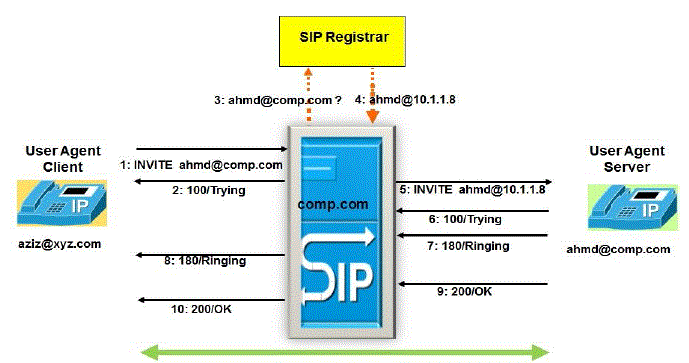 |
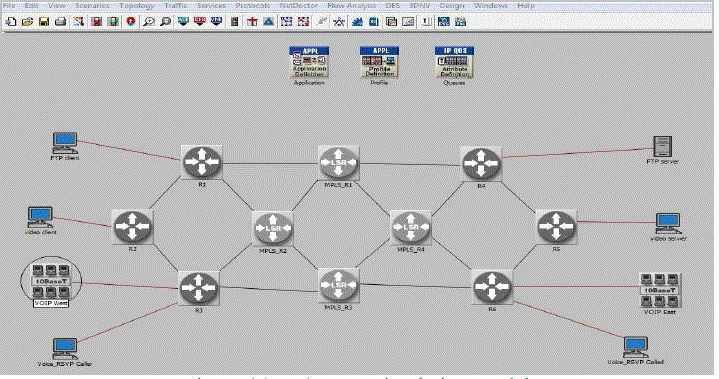 |
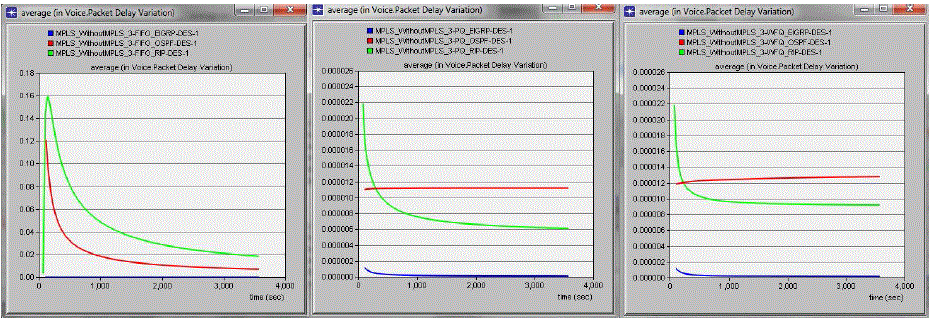 |
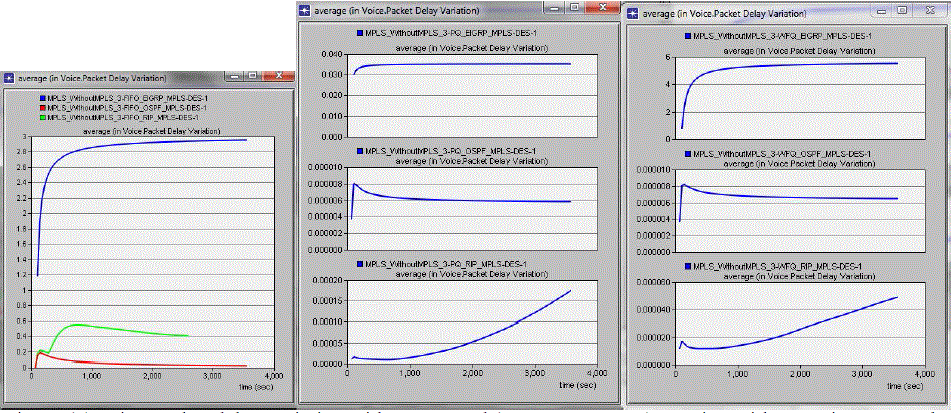 |
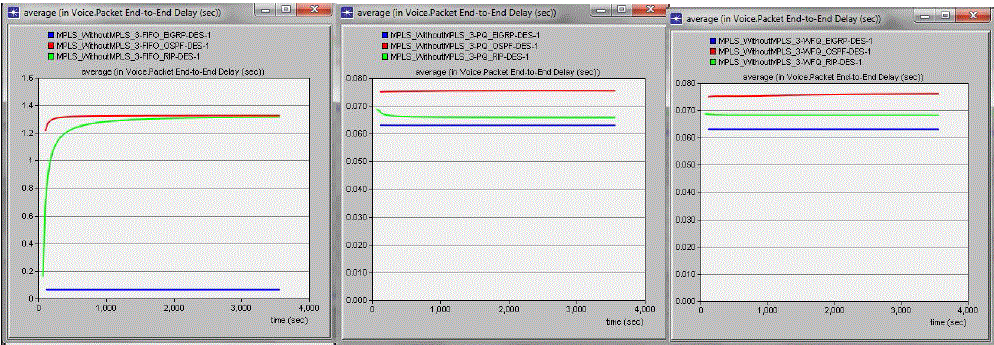 |
| Figure 1 |
Figure 2 |
Figure 3 |
Figure 4 |
Figure 5 |
|
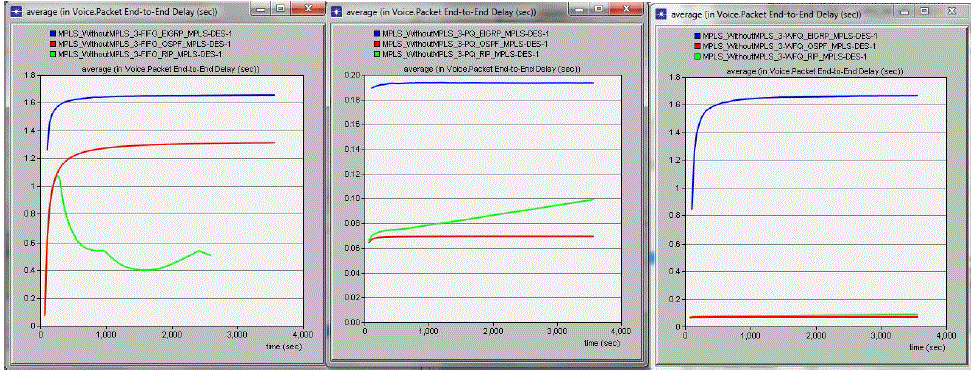 |
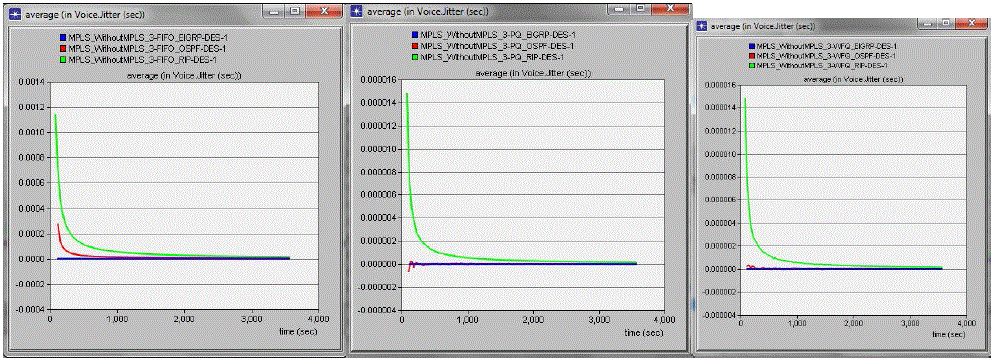 |
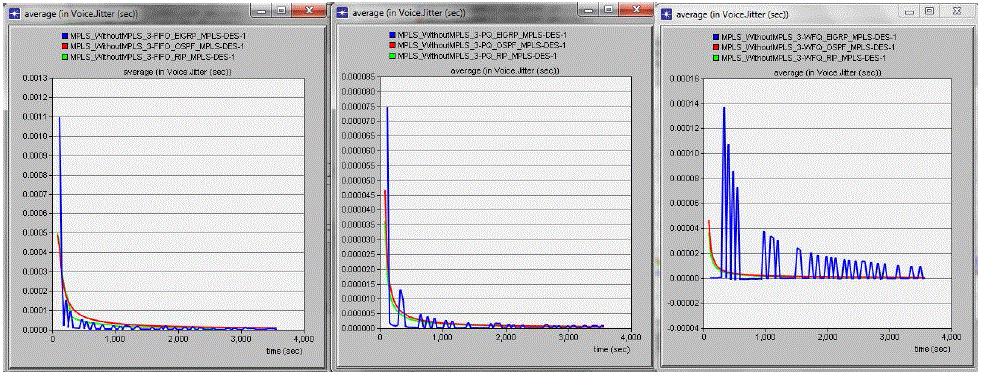 |
 |
 |
| Figure 6 |
Figure 7 |
Figure 8 |
Figure 9 |
Figure 10 |
|
References |
- James F. Kurose and Keith W. Ross: Computer Networking: A Top-Down Approach Featuring the Internet, 2012.
- DeepankarMedhi, KarthikeyanRamasamy: Network Routing, Protocols, and Architectures, Morgan Kaufmann Publishers, USA, 2007.
- L. Parziale, D. T. Britt, C. Davis, J. Forrester, W. Liu, C. Matthews, and N. Rosselot, “TCP/IP tutorial and technical overview,” IBM RedBook, USA, 2006.
- William Stallings: Computer Networking with Internet Protocols and Technology, Prentice Hall (Pearson Education), USA, 2004.
- Harry G. Perros: Connection-Oriented Networks SONET/SDH, ATM, MPLS and Optical Networks, John Wiley & Sons Ltd, UK, 2005.
- E. Rosen, A. Viswanathan, and R. Callon: Multiprotocol Label Switching Architecture, IETF RFC 3031, p. 61, 2001.
- Saleem N. Bhatti and Jon Crowcroft: QoS-sensitive flows: Issues in IP packet handling, IEEE Internet Computing, pp. 48-57, July/August, 2000.
- John Evans and Clarence Filsfils: Deploying IP and MPLS QOS for Multiservice Networks: Theory and Practice, Morgan Kaufmann Publishers, USA, 2007.
- Ram Balakrishnan: Advanced QoS for Multi-Service IP/MPLS Networks, Wiley Publishing, USA, 2008.
- Azeddien M. Sllame, Mohamed Aljafry: Performance Evaluation of Multimedia over IP/MPLS Networks, International Journal of Computer Theory and Engineering, Vol. 7, No. 4, 2015.
- OPNET Product Documentation v.11.0.A, OPNET Technologies, Inc., Bethesda, MD, 2004.
- Don Xu and LjiljanaTrajkovic: Performance Analysis of RIP, EIGRP, and OSPF using OPNET, OPNET University Program, Acadimic Edition, 2008.
- DamilolaOsikoya, KasinathBasu: A comparative Analysis of the performance of VoIP Traffic with Different Types of Scheduling Algorithms, International Journal of Computer Networking and Communication (IJCNAC), Vol. 2, No. 1, Feb. 2014.
- K.Balasundaram, T.Velmurugan, R.Suresh: Performance Analysis of Queuing Disciplines for Difference Services Using OPNET Tool, International Journal of Scientific Engineering and Technology, Vol. 3, No.1, pp : 47-50, Jan 2014
- Sarhan M. Musa MahamadouTembely Matthew N. O. Sadiku Pamela H. Obiomon: Modeling and Simulation of Queuing Scheduling Disciplines on Packet Delivery for Next Generation Internet Streaming Applications, International Journal of Computer and Information Technology, Vol. 3,No. 2, pp. 233-237,March 2014.
- ArchanaKudtarkar, ReenaSonkusare, DayanandAmbawade: Performance Analysis of Routing Protocols for Real Time Application, International Journal of Advanced Research in Computer and Communication Engineering, Vol. 3, No. 1, pp. 5072-5080, Jan. 2014.
- Vijayakumar V.Karthikeyani, Mohamed Omar: Implementation of Queuing Algorithm in Multipath Dynamic routing architecture for effective and secured data transfer in VoIP, International Journal of Engineering Trends and Technology (IJETT), Vol. 4, No. 4, pp.1226-1230, April 2013.
- A.H.Muhamad Amin: VoIP Performance Measurement Using QoS Parameters, The Second International Conference on Innovations in Information Technology (IIT’05), 2005.
|